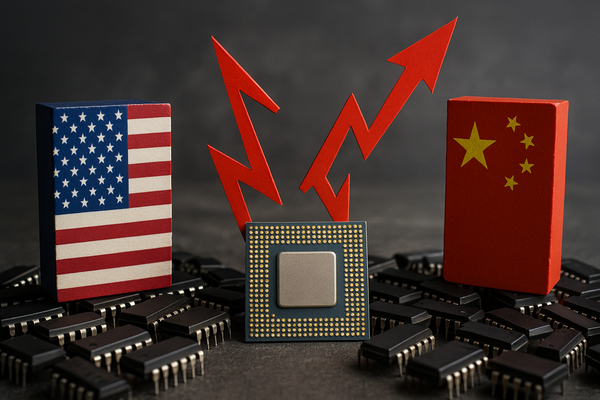
Tariff threats revive the U.S.–China trade fight, jolting global chips and AI supply chains. Markets buckled as Washington floated a massive tariff increase and senators advanced rules to curb AI chip exports to China. Beijing countered with tighter scrutiny and a new probe into a U.S. chip deal. The short-term hit is volatility and shipment risk. The long-term effect is faster reshoring and a costlier, more fragmented semiconductor stack. U.S. assets felt it first, Europe and Asia follow through supply chains, and emerging markets face higher tech import bills. This battle echoes 2018, but the stakes are bigger because AI runs on scarce GPUs and memory. Why it matters now: earnings season, policy headlines, and real customs checks are converging, driving price moves and capital spending decisions in real time.
What changed this week and the immediate market reaction
Tariff rhetoric returned to center stage. A fresh threat of a massive increase in duties on Chinese goods hit risk assets. The S&P 500 fell about 2.4% for the week, while the Nasdaq posted its worst day since April. A note titled “Trump Relights The Tariff Fuse” flagged a 2.7% S&P 500 slide, a 3.5% drop for the Nasdaq 100, and a 3.8% loss for the Magnificent Seven.
Semiconductors led declines. The Philadelphia Semiconductor Index fell roughly 4% after the tariff salvo. Headlines pointed to chip-specific catalysts. The U.S. Senate passed legislation requiring AI chipmakers to prioritize domestic buyers over China. Reports said China tightened customs scrutiny on Nvidia components. Beijing’s regulator opened an antitrust investigation into Qualcomm’s Autotalks deal.
Rare earth equities moved the other way. Shares of MP Materials (NYSE:MP) spiked as investors priced tighter Chinese export curbs on critical inputs.
Semiconductors in the crossfire: export controls and China actions
NVIDIA (NASDAQ:NVDA) and Advanced Micro Devices (NASDAQ:AMD) sold off after the Senate advanced an AI chip export bill targeting China. Separate coverage highlighted an ongoing shortage of compute, with customers booking years ahead, underscoring how policy can collide with still-red hot demand. NVDA flirted with record highs earlier in the week before reversing on the tariff headlines.
Qualcomm (NASDAQ:QCOM) dropped after China’s State Administration for Market Regulation launched a probe tied to its Autotalks acquisition. The investigation landed as tit-for-tat measures escalated. Broadcom (NASDAQ:AVGO) also eased, with analysts reminding clients that custom AI silicon growth is secular but sensitive to export limits.
Foundry and equipment provided nuance. Taiwan Semiconductor Manufacturing (NYSE:TSM) is expected to post strong Q3 FY2025 results, and one analysis called the tariff threat overblown for near-term earnings. Lam Research (NASDAQ:LRCX) and KLA (NASDAQ:KLAC) fell on the day, yet their order books remain levered to AI fabs and advanced packaging. Amkor Technology (NASDAQ:AMKR) was flagged as a backdoor AI beneficiary through test and packaging and as a reshoring play.
Second‑order effects across sectors
Cloud and AI infrastructure names continue to press ahead even as chips wobble. Microsoft (NASDAQ:MSFT) kept highlighting AI workloads and capex durability. Alphabet (NASDAQ:GOOGL) and Amazon.com (NASDAQ:AMZN) faced broader tech pressure, with AMZN shares falling around 5% on tariff headlines and consumer worries.
Data center builders and power suppliers are still in focus. Vertiv (NYSE:VRT) won fresh analyst target hikes tied to high‑density cooling and OCP‑aligned hardware. Reports noted that bitcoin miners are pivoting to AI colocation, while utilities like NRG Energy (NYSE:NRG) and Constellation Energy (NASDAQ:CEG) are seeing stronger power demand narratives linked to AI. These are slower‑moving offsets to chip volatility, but they matter for capital flows.
Logistics and retail felt the ripple. United Parcel Service (NYSE:UPS) warned some imports stuck at customs may be disposed of if clearance data is missing, a reminder of bottleneck risk. Consumer platforms with China sourcing exposure, including Apple (NASDAQ:AAPL), traded softly. Tesla (NASDAQ:TSLA) navigated China with a modest September sales uptick, but EVs remain exposed to battery materials any time trade lines harden.
Short‑term pain vs. long‑term rewiring
Near term, investors are recalibrating export risk and tariff timing. The policy mix now includes potential triple‑digit tariffs, a Senate bill that prioritizes U.S. buyers for AI chips, and regulatory actions inside China. That cocktail stresses quarterly shipment plans and pricing.
Long term, the incentives keep stacking toward geographic diversification. Analysts still reaffirmed bullish stances on AI leaders despite volatility, with new Overweight calls and target raises for NVDA and peers. A piece on TSMC reiterated strong quarterly momentum. Bernstein’s Stacy Rasgon underscored a shortage of compute with customers lining up years in advance, supporting durable demand signals even as routes and compliance regimes shift.
Memory and packaging look like the next choke points. A recent industry report projected high‑bandwidth memory could grow at a 21% annual clip to 2033, reflecting how AI models drive bandwidth and power needs. That pulls in Micron, packaging houses like AMKR, and equipment vendors across deposition, etch, and metrology.
Global and local lenses: how this fight differs from 2018
Back then, tariffs centered on broad consumer and industrial goods. Today, the locus is strategic tech. AI accelerators, advanced packaging, high‑bandwidth memory, and rare earths sit at the core. The UK and EU may not be primary actors, but their data centers and OEMs will absorb higher costs or longer lead times when U.S. and Asian nodes realign.
In Asia, Taiwan’s foundry capacity remains vital, while China’s regulators are signaling they will wield antitrust and customs tools. In the U.S., Congress is layering export priority rules on top of existing controls, while companies scale domestic fabs and advanced packaging to cut China dependency. The net effect is a more regionalized stack that trades lower efficiency for higher resilience.
Markets react first, then supply chains adapt. Equity swings look sharp, but capex plans for AI infrastructure remain intact, according to multiple notes. That sets up a push‑pull between policy shocks and secular demand.
What to watch next and how to adjust exposure
Key near‑term signposts can help frame the tape and the fundamentals:
- Policy path. Track the final language and timing of the Senate export bill. Watch tariff scope and effective dates.
- China enforcement. Follow outcomes of the Qualcomm (NASDAQ:QCOM) probe and any broadening of customs checks on AI chips and subsystems.
- Earnings updates. Listen for Taiwan Semiconductor Manufacturing (NYSE:TSM) commentary on order visibility, mix, and China risk. Scan AI leaders’ supply commentary for lead‑time changes.
- Materials flow. Monitor rare earth export headlines and responses from non‑China suppliers such as MP Materials (NYSE:MP).
- Downstream demand. Watch hyperscaler capex guides from Microsoft (NASDAQ:MSFT), Alphabet (NASDAQ:GOOGL), and Amazon.com (NASDAQ:AMZN), and data center builders like Vertiv (NYSE:VRT).
Possible positioning ideas, purely informational:
- Stress‑test China revenue and supply exposure within semis, tools, and handset chains. Differentiate firms with domestic capacity and diversified end markets.
- Consider second‑order AI infrastructure beneficiaries. Power, cooling, and grid names can offset chip volatility when demand for data centers rises.
- Track packaging and memory. Advanced packaging capacity and high‑bandwidth memory are tight and policy sensitive.
- Use baskets to manage event risk. Semiconductor ETFs can blunt single‑name shocks tied to probes or customs actions.
- Follow rare earth and magnet supply alternatives. Policy shifts can reprice upstream inputs faster than end products.
Bottom line: the tariff drumbeat and China’s regulatory steps raised equity volatility, especially in semis. Yet the AI buildout keeps driving orders for compute, memory, tools, and power. The next phase is less about demand existing, more about where and how the supply gets built and shipped.












